Design of Communication Systems for an Industrial Building Network
VerifiedAdded on 2023/03/30
|17
|2808
|100
Project
AI Summary
This assignment presents a detailed communication systems design for a two-story industrial building, encompassing both factory and office floors. It begins with an analysis of network requirements, including data rates for machines, supervisors, and office computers. The design incorporates various technologies such as Ethernet, fiber optic, wireless networks, and VLANs, along with relevant standards like IEEE 802.11 and 802.3. The solution outlines the implementation of network protocols, including TCP/IP, HTTP, and security protocols like SSH and HTTPS. Hardware and software implementations are discussed, followed by the network layout and topology. The assignment also addresses limitations of the selected technologies. The solution includes calculations for data requirements, equipment capacities, and network performance, along with a list of equipment with their specifications. The design aims to ensure efficient and reliable communication throughout the industrial building, addressing the needs of both the factory floor and the office environment.
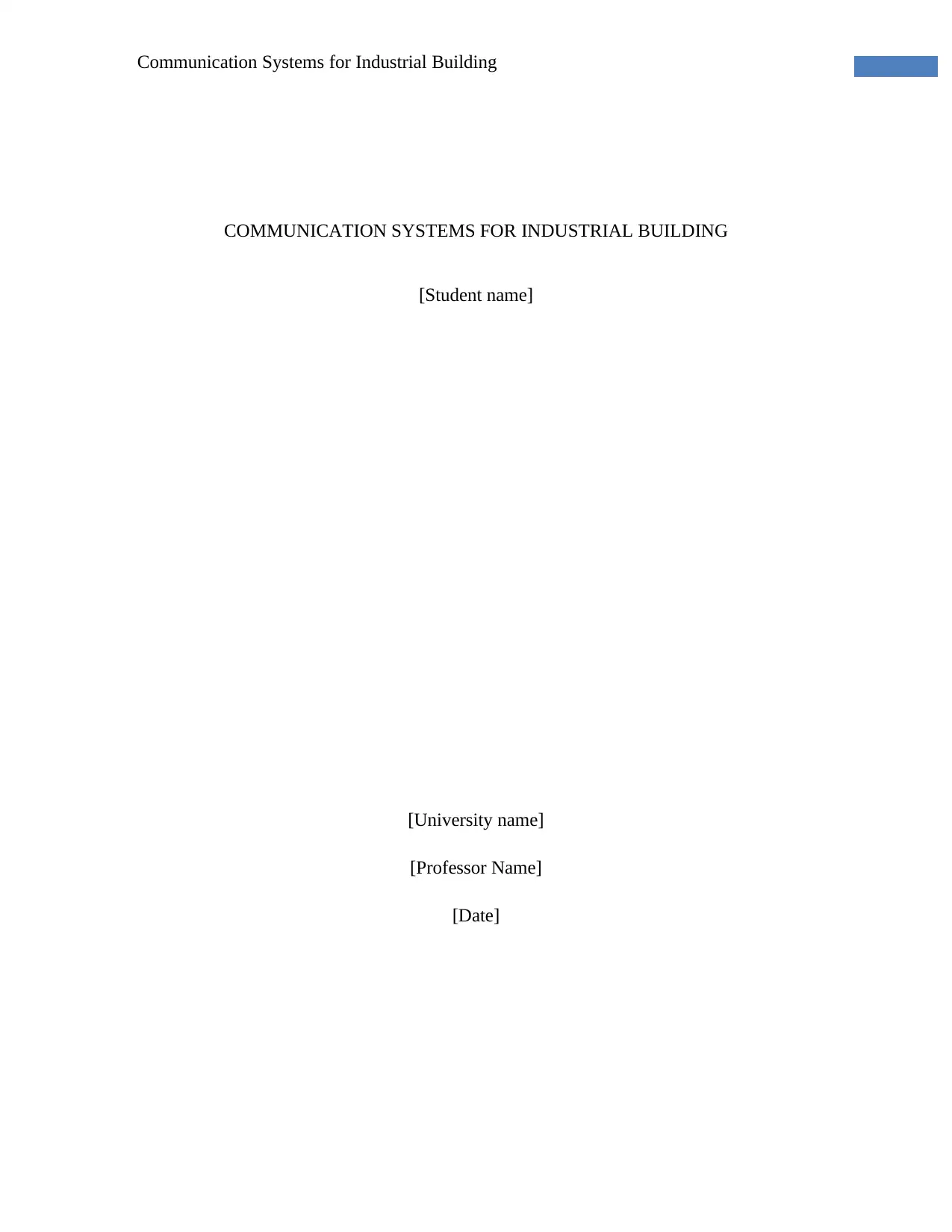
1Communication Systems for Industrial Building
COMMUNICATION SYSTEMS FOR INDUSTRIAL BUILDING
[Student name]
[University name]
[Professor Name]
[Date]
COMMUNICATION SYSTEMS FOR INDUSTRIAL BUILDING
[Student name]
[University name]
[Professor Name]
[Date]
Paraphrase This Document
Need a fresh take? Get an instant paraphrase of this document with our AI Paraphraser
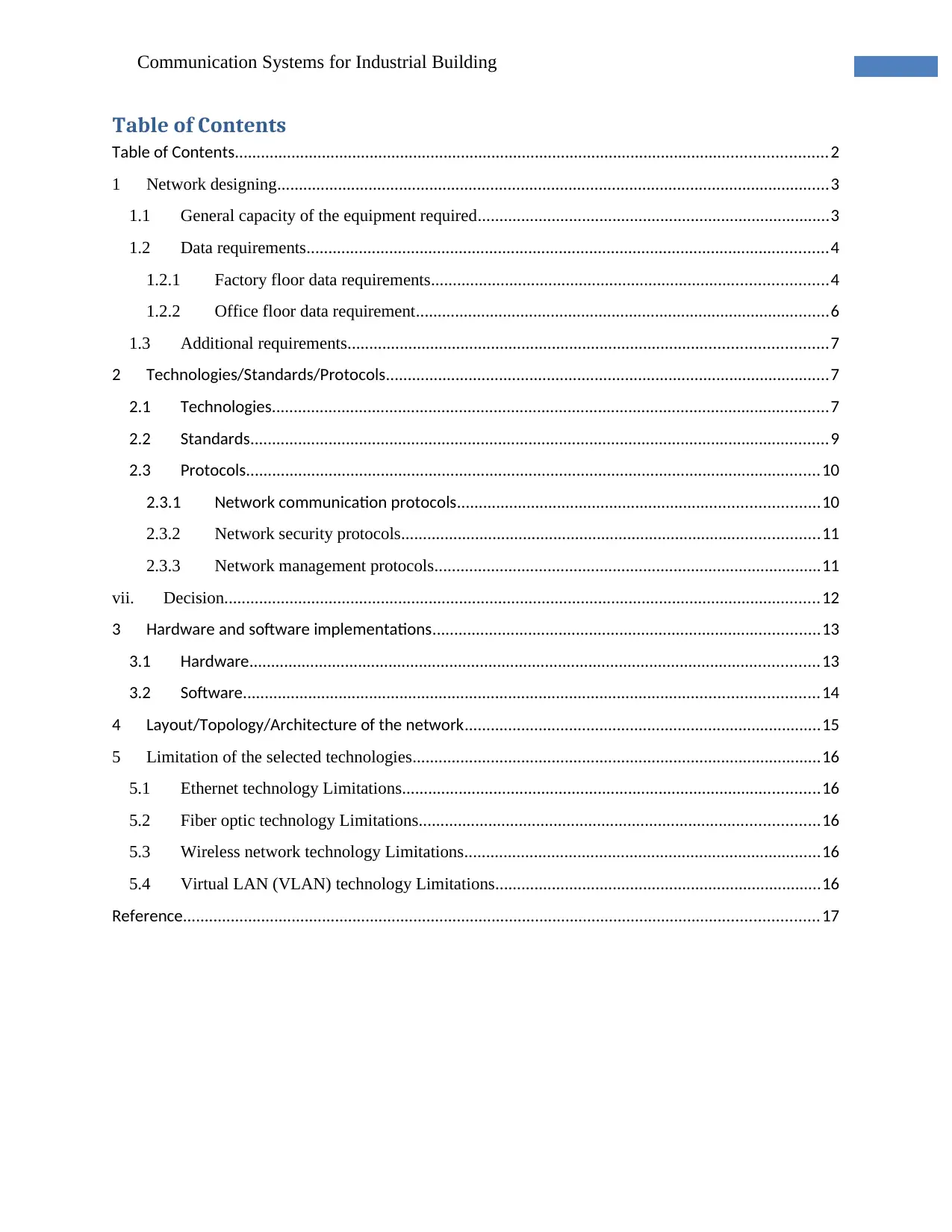
2Communication Systems for Industrial Building
Table of Contents
Table of Contents........................................................................................................................................2
1 Network designing...............................................................................................................................3
1.1 General capacity of the equipment required.................................................................................3
1.2 Data requirements........................................................................................................................4
1.2.1 Factory floor data requirements...........................................................................................4
1.2.2 Office floor data requirement...............................................................................................6
1.3 Additional requirements..............................................................................................................7
2 Technologies/Standards/Protocols......................................................................................................7
2.1 Technologies................................................................................................................................7
2.2 Standards.....................................................................................................................................9
2.3 Protocols....................................................................................................................................10
2.3.1 Network communication protocols...................................................................................10
2.3.2 Network security protocols................................................................................................11
2.3.3 Network management protocols.........................................................................................11
vii. Decision.........................................................................................................................................12
3 Hardware and software implementations.........................................................................................13
3.1 Hardware...................................................................................................................................13
3.2 Software....................................................................................................................................14
4 Layout/Topology/Architecture of the network..................................................................................15
5 Limitation of the selected technologies..............................................................................................16
5.1 Ethernet technology Limitations................................................................................................16
5.2 Fiber optic technology Limitations............................................................................................16
5.3 Wireless network technology Limitations..................................................................................16
5.4 Virtual LAN (VLAN) technology Limitations...........................................................................16
Reference..................................................................................................................................................17
Table of Contents
Table of Contents........................................................................................................................................2
1 Network designing...............................................................................................................................3
1.1 General capacity of the equipment required.................................................................................3
1.2 Data requirements........................................................................................................................4
1.2.1 Factory floor data requirements...........................................................................................4
1.2.2 Office floor data requirement...............................................................................................6
1.3 Additional requirements..............................................................................................................7
2 Technologies/Standards/Protocols......................................................................................................7
2.1 Technologies................................................................................................................................7
2.2 Standards.....................................................................................................................................9
2.3 Protocols....................................................................................................................................10
2.3.1 Network communication protocols...................................................................................10
2.3.2 Network security protocols................................................................................................11
2.3.3 Network management protocols.........................................................................................11
vii. Decision.........................................................................................................................................12
3 Hardware and software implementations.........................................................................................13
3.1 Hardware...................................................................................................................................13
3.2 Software....................................................................................................................................14
4 Layout/Topology/Architecture of the network..................................................................................15
5 Limitation of the selected technologies..............................................................................................16
5.1 Ethernet technology Limitations................................................................................................16
5.2 Fiber optic technology Limitations............................................................................................16
5.3 Wireless network technology Limitations..................................................................................16
5.4 Virtual LAN (VLAN) technology Limitations...........................................................................16
Reference..................................................................................................................................................17
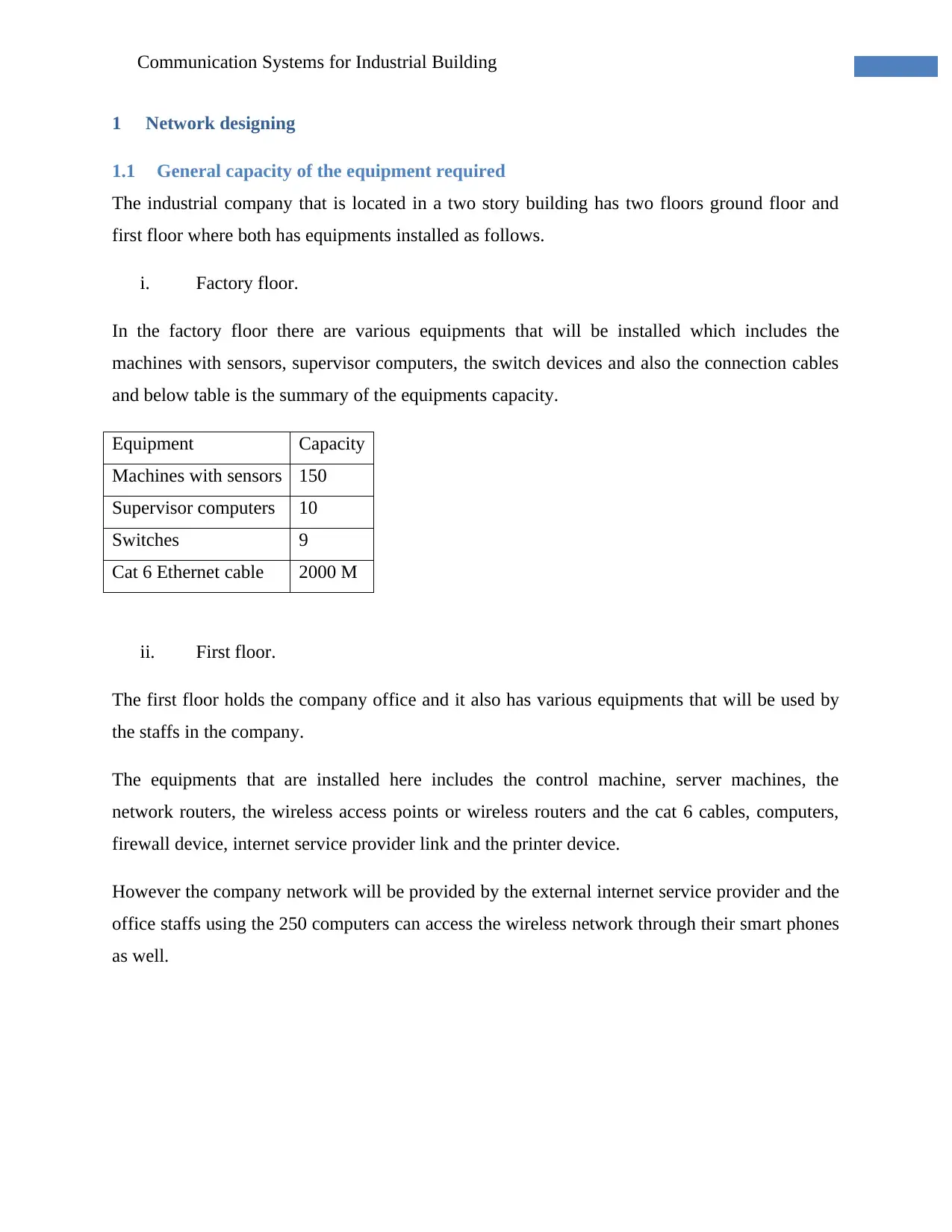
3Communication Systems for Industrial Building
1 Network designing
1.1 General capacity of the equipment required
The industrial company that is located in a two story building has two floors ground floor and
first floor where both has equipments installed as follows.
i. Factory floor.
In the factory floor there are various equipments that will be installed which includes the
machines with sensors, supervisor computers, the switch devices and also the connection cables
and below table is the summary of the equipments capacity.
Equipment Capacity
Machines with sensors 150
Supervisor computers 10
Switches 9
Cat 6 Ethernet cable 2000 M
ii. First floor.
The first floor holds the company office and it also has various equipments that will be used by
the staffs in the company.
The equipments that are installed here includes the control machine, server machines, the
network routers, the wireless access points or wireless routers and the cat 6 cables, computers,
firewall device, internet service provider link and the printer device.
However the company network will be provided by the external internet service provider and the
office staffs using the 250 computers can access the wireless network through their smart phones
as well.
1 Network designing
1.1 General capacity of the equipment required
The industrial company that is located in a two story building has two floors ground floor and
first floor where both has equipments installed as follows.
i. Factory floor.
In the factory floor there are various equipments that will be installed which includes the
machines with sensors, supervisor computers, the switch devices and also the connection cables
and below table is the summary of the equipments capacity.
Equipment Capacity
Machines with sensors 150
Supervisor computers 10
Switches 9
Cat 6 Ethernet cable 2000 M
ii. First floor.
The first floor holds the company office and it also has various equipments that will be used by
the staffs in the company.
The equipments that are installed here includes the control machine, server machines, the
network routers, the wireless access points or wireless routers and the cat 6 cables, computers,
firewall device, internet service provider link and the printer device.
However the company network will be provided by the external internet service provider and the
office staffs using the 250 computers can access the wireless network through their smart phones
as well.
⊘ This is a preview!⊘
Do you want full access?
Subscribe today to unlock all pages.

Trusted by 1+ million students worldwide
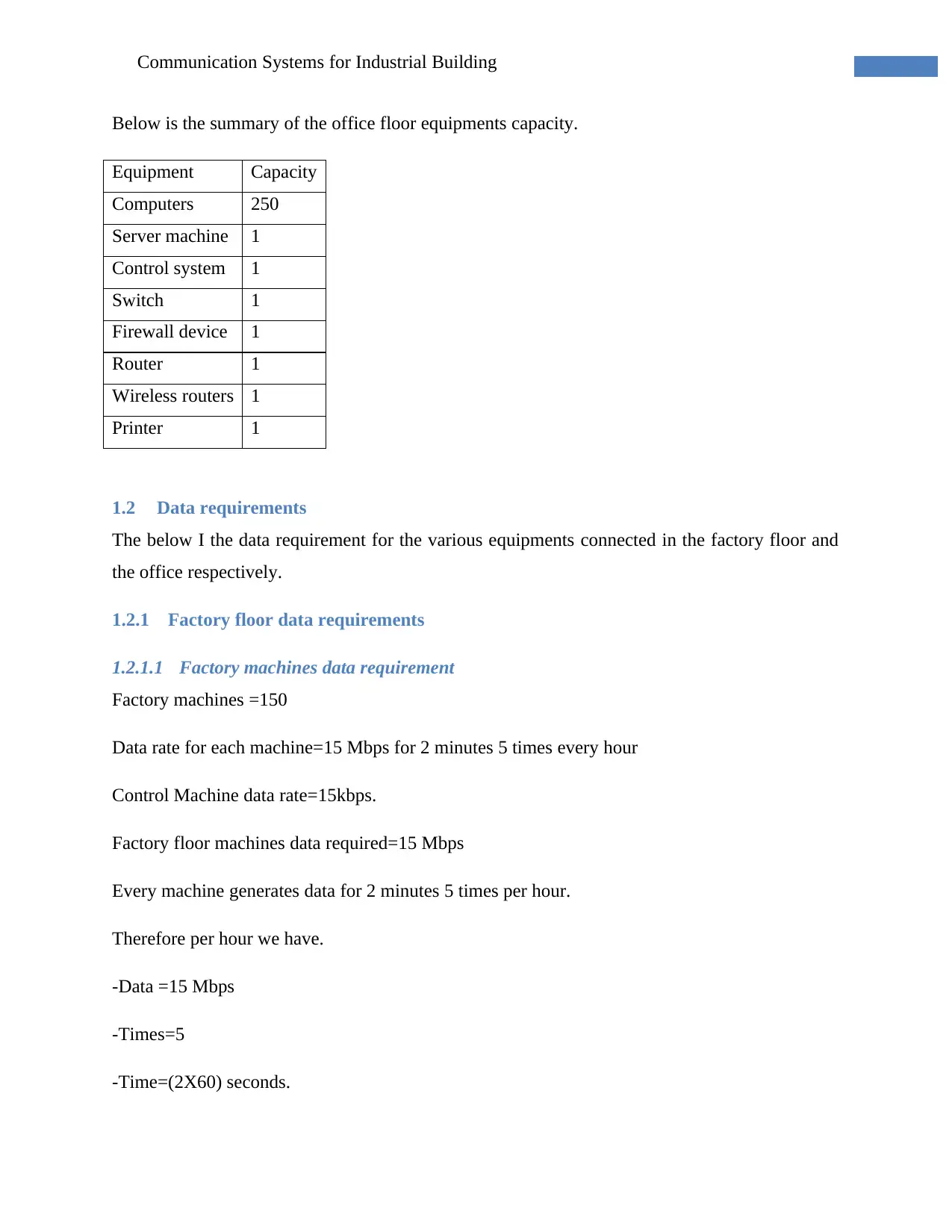
4Communication Systems for Industrial Building
Below is the summary of the office floor equipments capacity.
Equipment Capacity
Computers 250
Server machine 1
Control system 1
Switch 1
Firewall device 1
Router 1
Wireless routers 1
Printer 1
1.2 Data requirements
The below I the data requirement for the various equipments connected in the factory floor and
the office respectively.
1.2.1 Factory floor data requirements
1.2.1.1 Factory machines data requirement
Factory machines =150
Data rate for each machine=15 Mbps for 2 minutes 5 times every hour
Control Machine data rate=15kbps.
Factory floor machines data required=15 Mbps
Every machine generates data for 2 minutes 5 times per hour.
Therefore per hour we have.
-Data =15 Mbps
-Times=5
-Time=(2X60) seconds.
Below is the summary of the office floor equipments capacity.
Equipment Capacity
Computers 250
Server machine 1
Control system 1
Switch 1
Firewall device 1
Router 1
Wireless routers 1
Printer 1
1.2 Data requirements
The below I the data requirement for the various equipments connected in the factory floor and
the office respectively.
1.2.1 Factory floor data requirements
1.2.1.1 Factory machines data requirement
Factory machines =150
Data rate for each machine=15 Mbps for 2 minutes 5 times every hour
Control Machine data rate=15kbps.
Factory floor machines data required=15 Mbps
Every machine generates data for 2 minutes 5 times per hour.
Therefore per hour we have.
-Data =15 Mbps
-Times=5
-Time=(2X60) seconds.
Paraphrase This Document
Need a fresh take? Get an instant paraphrase of this document with our AI Paraphraser
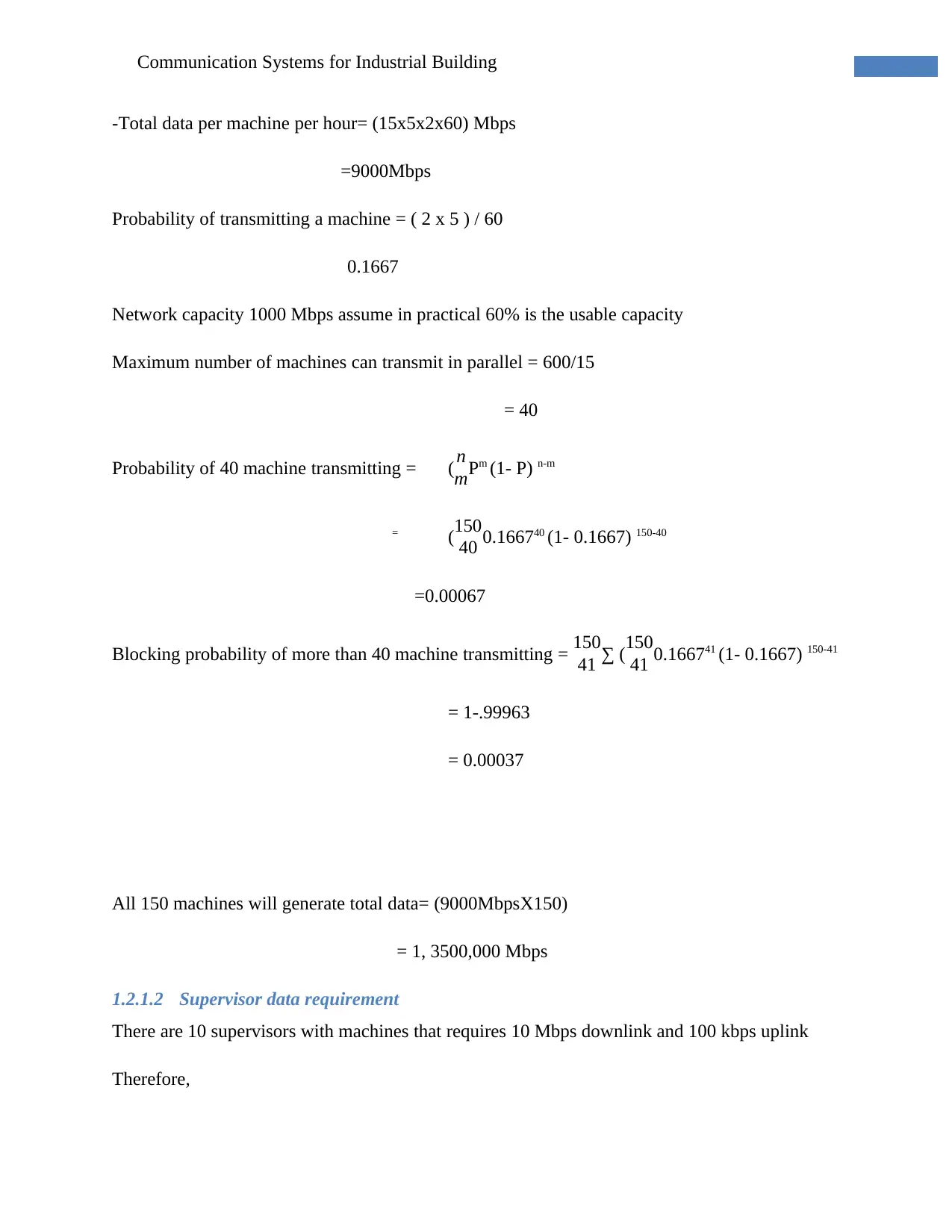
5Communication Systems for Industrial Building
-Total data per machine per hour= (15x5x2x60) Mbps
=9000Mbps
Probability of transmitting a machine = ( 2 x 5 ) / 60
0.1667
Network capacity 1000 Mbps assume in practical 60% is the usable capacity
Maximum number of machines can transmit in parallel = 600/15
= 40
Probability of 40 machine transmitting = ( n
mPm (1- P) n-m
= (
150
40 0.166740 (1- 0.1667) 150-40
=0.00067
Blocking probability of more than 40 machine transmitting = 150
41 ∑ (150
41 0.166741 (1- 0.1667) 150-41
= 1-.99963
= 0.00037
All 150 machines will generate total data= (9000MbpsX150)
= 1, 3500,000 Mbps
1.2.1.2 Supervisor data requirement
There are 10 supervisors with machines that requires 10 Mbps downlink and 100 kbps uplink
Therefore,
-Total data per machine per hour= (15x5x2x60) Mbps
=9000Mbps
Probability of transmitting a machine = ( 2 x 5 ) / 60
0.1667
Network capacity 1000 Mbps assume in practical 60% is the usable capacity
Maximum number of machines can transmit in parallel = 600/15
= 40
Probability of 40 machine transmitting = ( n
mPm (1- P) n-m
= (
150
40 0.166740 (1- 0.1667) 150-40
=0.00067
Blocking probability of more than 40 machine transmitting = 150
41 ∑ (150
41 0.166741 (1- 0.1667) 150-41
= 1-.99963
= 0.00037
All 150 machines will generate total data= (9000MbpsX150)
= 1, 3500,000 Mbps
1.2.1.2 Supervisor data requirement
There are 10 supervisors with machines that requires 10 Mbps downlink and 100 kbps uplink
Therefore,
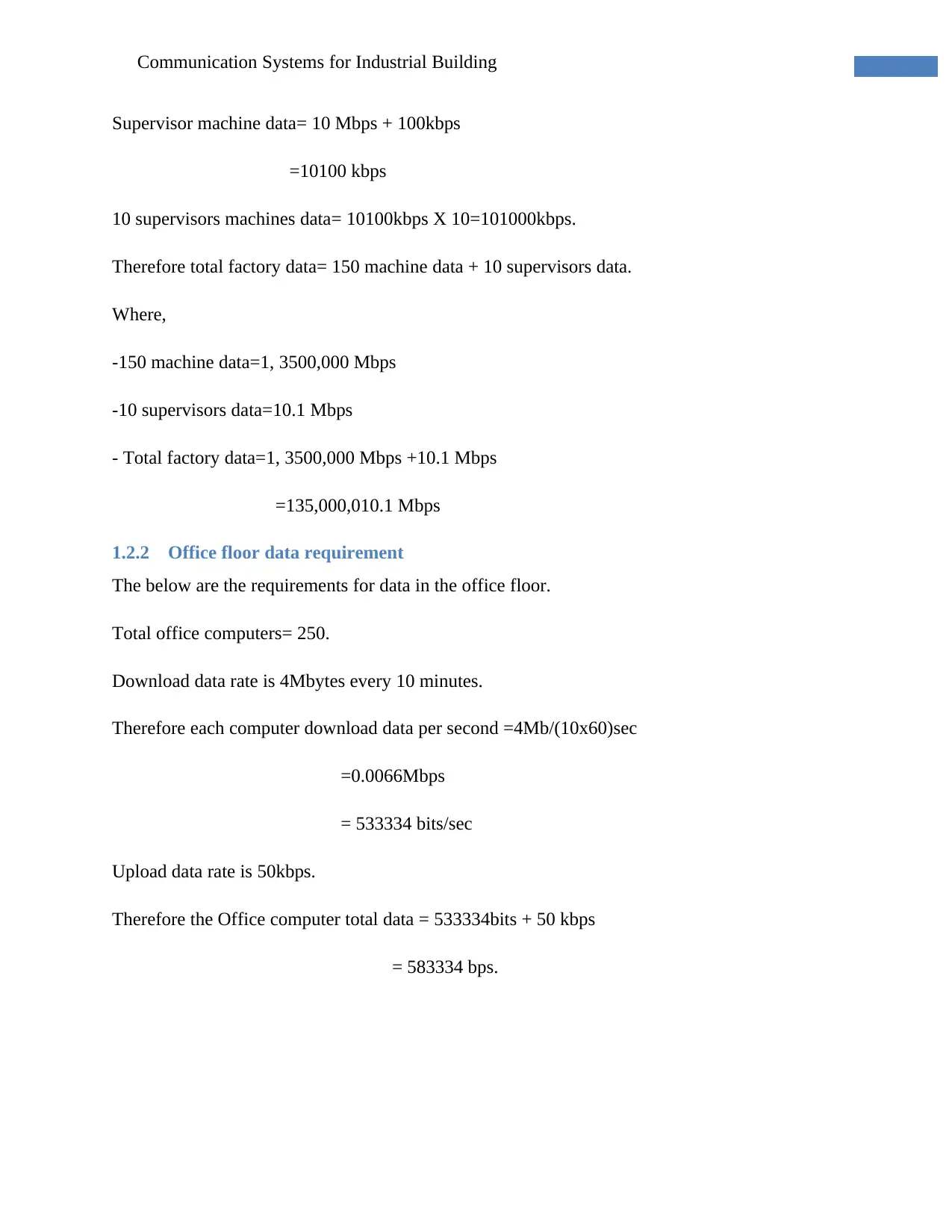
6Communication Systems for Industrial Building
Supervisor machine data= 10 Mbps + 100kbps
=10100 kbps
10 supervisors machines data= 10100kbps X 10=101000kbps.
Therefore total factory data= 150 machine data + 10 supervisors data.
Where,
-150 machine data=1, 3500,000 Mbps
-10 supervisors data=10.1 Mbps
- Total factory data=1, 3500,000 Mbps +10.1 Mbps
=135,000,010.1 Mbps
1.2.2 Office floor data requirement
The below are the requirements for data in the office floor.
Total office computers= 250.
Download data rate is 4Mbytes every 10 minutes.
Therefore each computer download data per second =4Mb/(10x60)sec
=0.0066Mbps
= 533334 bits/sec
Upload data rate is 50kbps.
Therefore the Office computer total data = 533334bits + 50 kbps
= 583334 bps.
Supervisor machine data= 10 Mbps + 100kbps
=10100 kbps
10 supervisors machines data= 10100kbps X 10=101000kbps.
Therefore total factory data= 150 machine data + 10 supervisors data.
Where,
-150 machine data=1, 3500,000 Mbps
-10 supervisors data=10.1 Mbps
- Total factory data=1, 3500,000 Mbps +10.1 Mbps
=135,000,010.1 Mbps
1.2.2 Office floor data requirement
The below are the requirements for data in the office floor.
Total office computers= 250.
Download data rate is 4Mbytes every 10 minutes.
Therefore each computer download data per second =4Mb/(10x60)sec
=0.0066Mbps
= 533334 bits/sec
Upload data rate is 50kbps.
Therefore the Office computer total data = 533334bits + 50 kbps
= 583334 bps.
⊘ This is a preview!⊘
Do you want full access?
Subscribe today to unlock all pages.

Trusted by 1+ million students worldwide
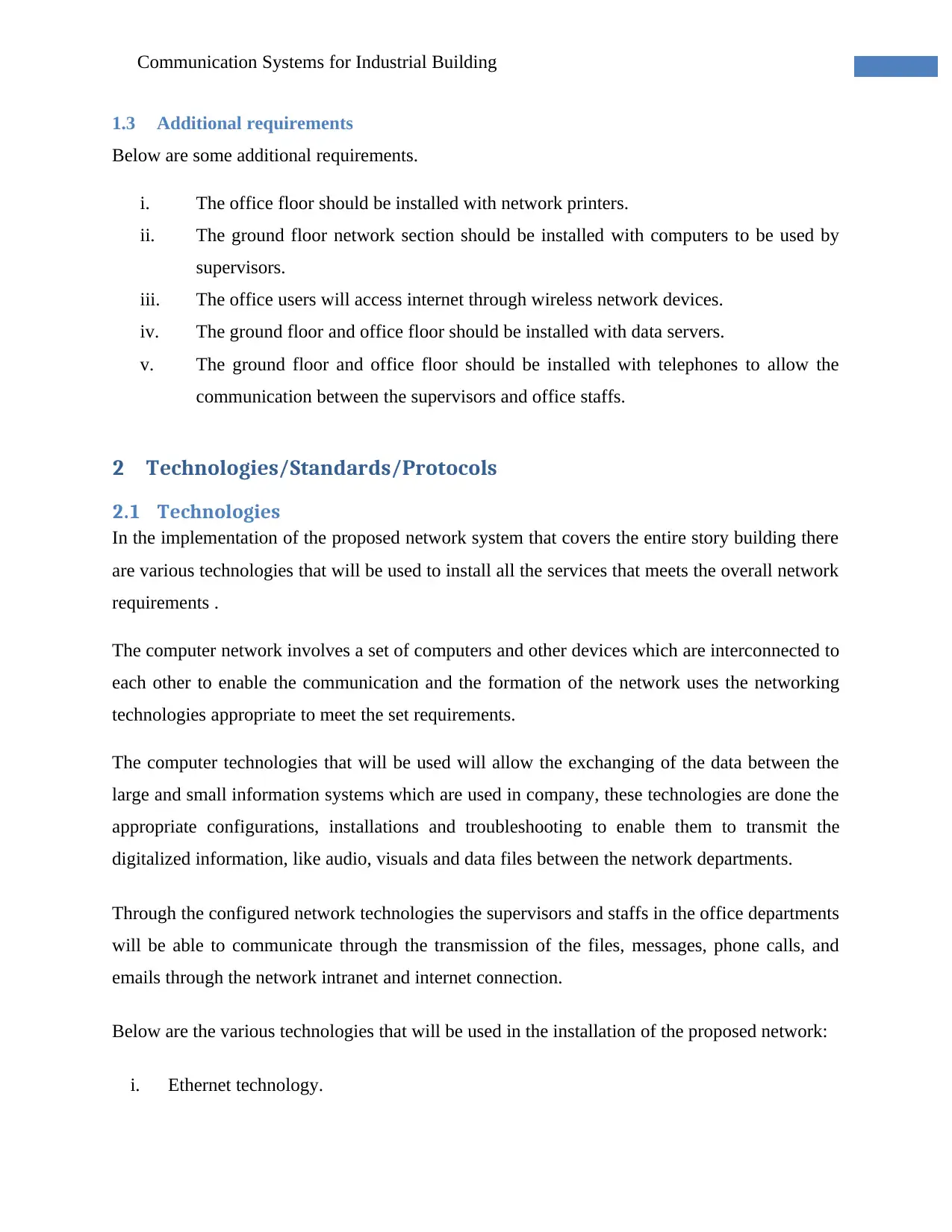
7Communication Systems for Industrial Building
1.3 Additional requirements
Below are some additional requirements.
i. The office floor should be installed with network printers.
ii. The ground floor network section should be installed with computers to be used by
supervisors.
iii. The office users will access internet through wireless network devices.
iv. The ground floor and office floor should be installed with data servers.
v. The ground floor and office floor should be installed with telephones to allow the
communication between the supervisors and office staffs.
2 Technologies/Standards/Protocols
2.1 Technologies
In the implementation of the proposed network system that covers the entire story building there
are various technologies that will be used to install all the services that meets the overall network
requirements .
The computer network involves a set of computers and other devices which are interconnected to
each other to enable the communication and the formation of the network uses the networking
technologies appropriate to meet the set requirements.
The computer technologies that will be used will allow the exchanging of the data between the
large and small information systems which are used in company, these technologies are done the
appropriate configurations, installations and troubleshooting to enable them to transmit the
digitalized information, like audio, visuals and data files between the network departments.
Through the configured network technologies the supervisors and staffs in the office departments
will be able to communicate through the transmission of the files, messages, phone calls, and
emails through the network intranet and internet connection.
Below are the various technologies that will be used in the installation of the proposed network:
i. Ethernet technology.
1.3 Additional requirements
Below are some additional requirements.
i. The office floor should be installed with network printers.
ii. The ground floor network section should be installed with computers to be used by
supervisors.
iii. The office users will access internet through wireless network devices.
iv. The ground floor and office floor should be installed with data servers.
v. The ground floor and office floor should be installed with telephones to allow the
communication between the supervisors and office staffs.
2 Technologies/Standards/Protocols
2.1 Technologies
In the implementation of the proposed network system that covers the entire story building there
are various technologies that will be used to install all the services that meets the overall network
requirements .
The computer network involves a set of computers and other devices which are interconnected to
each other to enable the communication and the formation of the network uses the networking
technologies appropriate to meet the set requirements.
The computer technologies that will be used will allow the exchanging of the data between the
large and small information systems which are used in company, these technologies are done the
appropriate configurations, installations and troubleshooting to enable them to transmit the
digitalized information, like audio, visuals and data files between the network departments.
Through the configured network technologies the supervisors and staffs in the office departments
will be able to communicate through the transmission of the files, messages, phone calls, and
emails through the network intranet and internet connection.
Below are the various technologies that will be used in the installation of the proposed network:
i. Ethernet technology.
Paraphrase This Document
Need a fresh take? Get an instant paraphrase of this document with our AI Paraphraser
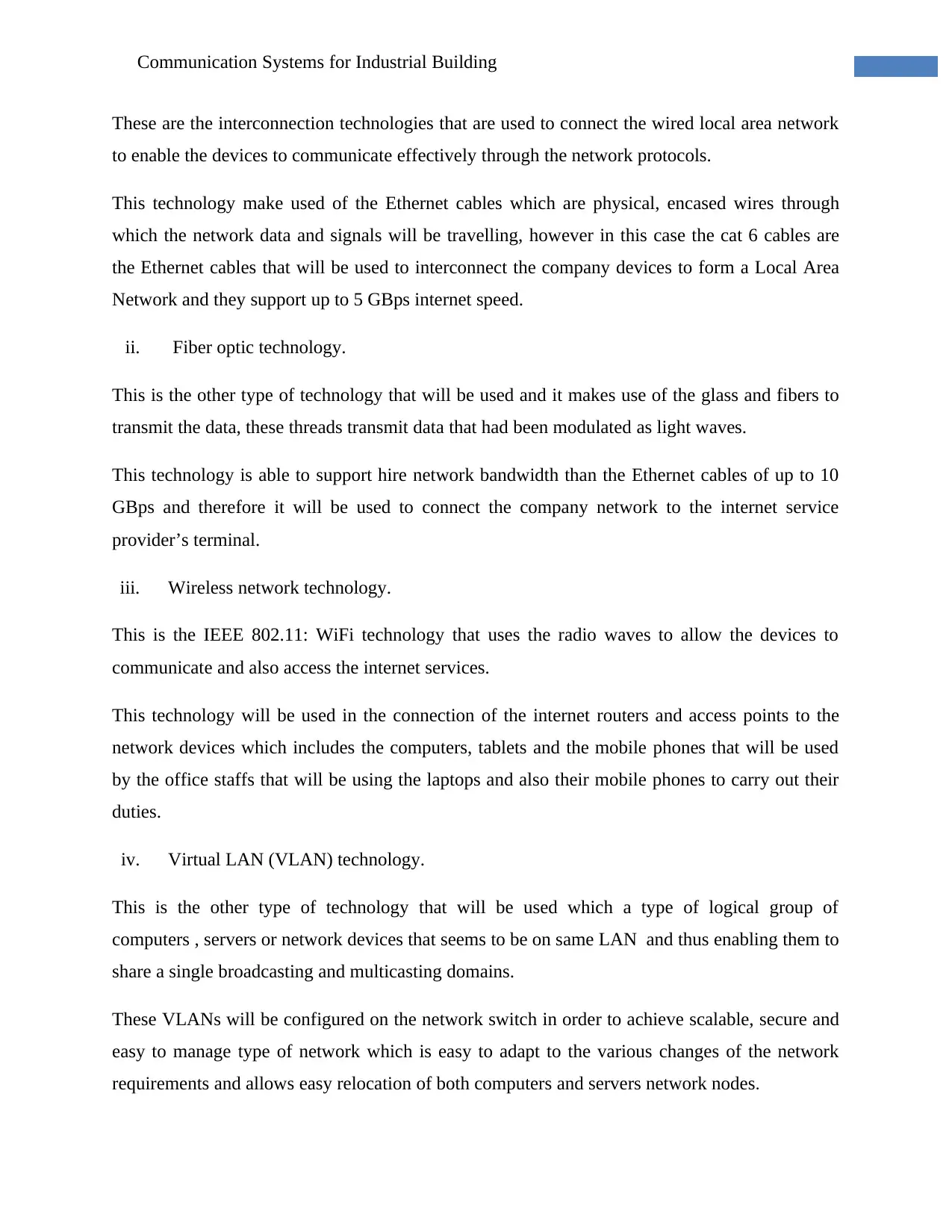
8Communication Systems for Industrial Building
These are the interconnection technologies that are used to connect the wired local area network
to enable the devices to communicate effectively through the network protocols.
This technology make used of the Ethernet cables which are physical, encased wires through
which the network data and signals will be travelling, however in this case the cat 6 cables are
the Ethernet cables that will be used to interconnect the company devices to form a Local Area
Network and they support up to 5 GBps internet speed.
ii. Fiber optic technology.
This is the other type of technology that will be used and it makes use of the glass and fibers to
transmit the data, these threads transmit data that had been modulated as light waves.
This technology is able to support hire network bandwidth than the Ethernet cables of up to 10
GBps and therefore it will be used to connect the company network to the internet service
provider’s terminal.
iii. Wireless network technology.
This is the IEEE 802.11: WiFi technology that uses the radio waves to allow the devices to
communicate and also access the internet services.
This technology will be used in the connection of the internet routers and access points to the
network devices which includes the computers, tablets and the mobile phones that will be used
by the office staffs that will be using the laptops and also their mobile phones to carry out their
duties.
iv. Virtual LAN (VLAN) technology.
This is the other type of technology that will be used which a type of logical group of
computers , servers or network devices that seems to be on same LAN and thus enabling them to
share a single broadcasting and multicasting domains.
These VLANs will be configured on the network switch in order to achieve scalable, secure and
easy to manage type of network which is easy to adapt to the various changes of the network
requirements and allows easy relocation of both computers and servers network nodes.
These are the interconnection technologies that are used to connect the wired local area network
to enable the devices to communicate effectively through the network protocols.
This technology make used of the Ethernet cables which are physical, encased wires through
which the network data and signals will be travelling, however in this case the cat 6 cables are
the Ethernet cables that will be used to interconnect the company devices to form a Local Area
Network and they support up to 5 GBps internet speed.
ii. Fiber optic technology.
This is the other type of technology that will be used and it makes use of the glass and fibers to
transmit the data, these threads transmit data that had been modulated as light waves.
This technology is able to support hire network bandwidth than the Ethernet cables of up to 10
GBps and therefore it will be used to connect the company network to the internet service
provider’s terminal.
iii. Wireless network technology.
This is the IEEE 802.11: WiFi technology that uses the radio waves to allow the devices to
communicate and also access the internet services.
This technology will be used in the connection of the internet routers and access points to the
network devices which includes the computers, tablets and the mobile phones that will be used
by the office staffs that will be using the laptops and also their mobile phones to carry out their
duties.
iv. Virtual LAN (VLAN) technology.
This is the other type of technology that will be used which a type of logical group of
computers , servers or network devices that seems to be on same LAN and thus enabling them to
share a single broadcasting and multicasting domains.
These VLANs will be configured on the network switch in order to achieve scalable, secure and
easy to manage type of network which is easy to adapt to the various changes of the network
requirements and allows easy relocation of both computers and servers network nodes.
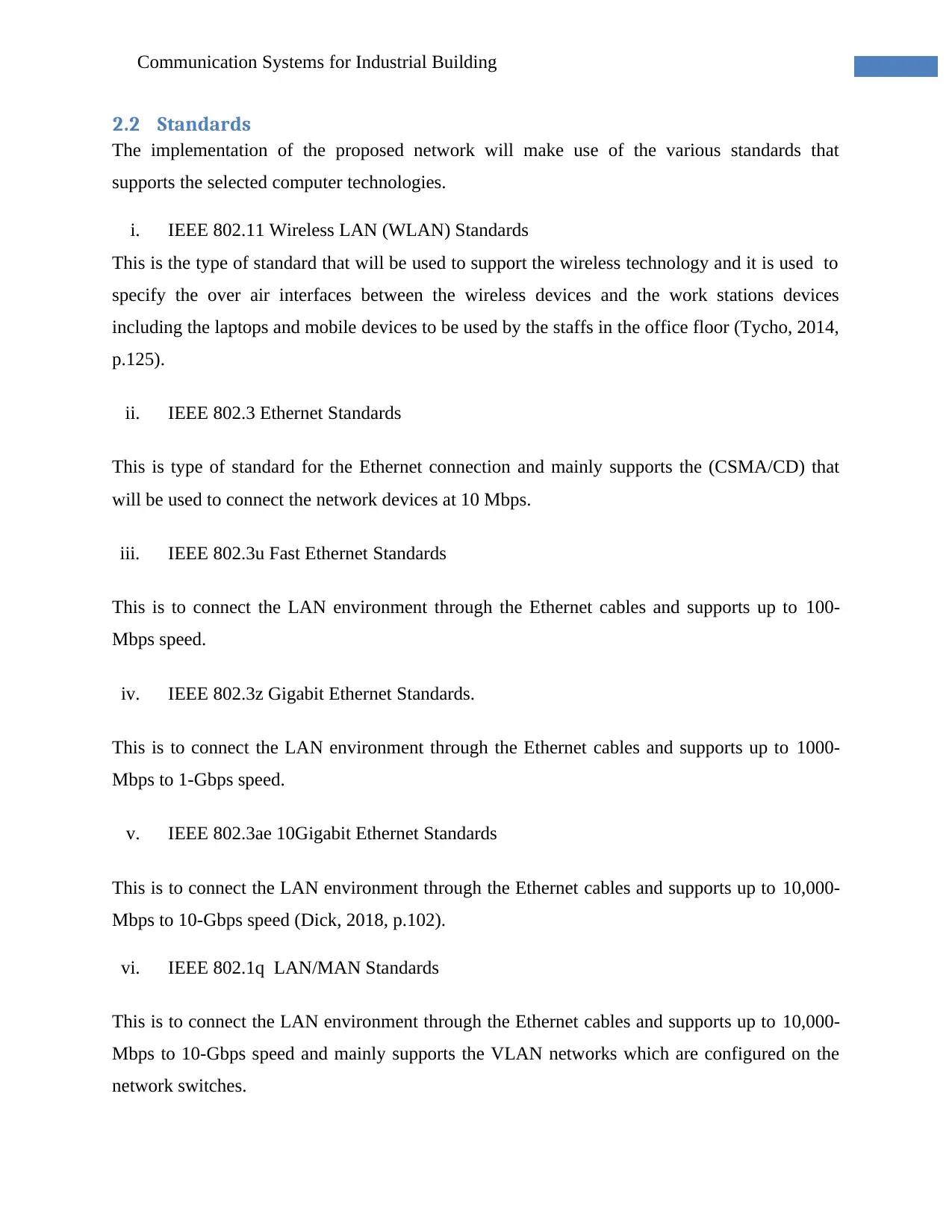
9Communication Systems for Industrial Building
2.2 Standards
The implementation of the proposed network will make use of the various standards that
supports the selected computer technologies.
i. IEEE 802.11 Wireless LAN (WLAN) Standards
This is the type of standard that will be used to support the wireless technology and it is used to
specify the over air interfaces between the wireless devices and the work stations devices
including the laptops and mobile devices to be used by the staffs in the office floor (Tycho, 2014,
p.125).
ii. IEEE 802.3 Ethernet Standards
This is type of standard for the Ethernet connection and mainly supports the (CSMA/CD) that
will be used to connect the network devices at 10 Mbps.
iii. IEEE 802.3u Fast Ethernet Standards
This is to connect the LAN environment through the Ethernet cables and supports up to 100-
Mbps speed.
iv. IEEE 802.3z Gigabit Ethernet Standards.
This is to connect the LAN environment through the Ethernet cables and supports up to 1000-
Mbps to 1-Gbps speed.
v. IEEE 802.3ae 10Gigabit Ethernet Standards
This is to connect the LAN environment through the Ethernet cables and supports up to 10,000-
Mbps to 10-Gbps speed (Dick, 2018, p.102).
vi. IEEE 802.1q LAN/MAN Standards
This is to connect the LAN environment through the Ethernet cables and supports up to 10,000-
Mbps to 10-Gbps speed and mainly supports the VLAN networks which are configured on the
network switches.
2.2 Standards
The implementation of the proposed network will make use of the various standards that
supports the selected computer technologies.
i. IEEE 802.11 Wireless LAN (WLAN) Standards
This is the type of standard that will be used to support the wireless technology and it is used to
specify the over air interfaces between the wireless devices and the work stations devices
including the laptops and mobile devices to be used by the staffs in the office floor (Tycho, 2014,
p.125).
ii. IEEE 802.3 Ethernet Standards
This is type of standard for the Ethernet connection and mainly supports the (CSMA/CD) that
will be used to connect the network devices at 10 Mbps.
iii. IEEE 802.3u Fast Ethernet Standards
This is to connect the LAN environment through the Ethernet cables and supports up to 100-
Mbps speed.
iv. IEEE 802.3z Gigabit Ethernet Standards.
This is to connect the LAN environment through the Ethernet cables and supports up to 1000-
Mbps to 1-Gbps speed.
v. IEEE 802.3ae 10Gigabit Ethernet Standards
This is to connect the LAN environment through the Ethernet cables and supports up to 10,000-
Mbps to 10-Gbps speed (Dick, 2018, p.102).
vi. IEEE 802.1q LAN/MAN Standards
This is to connect the LAN environment through the Ethernet cables and supports up to 10,000-
Mbps to 10-Gbps speed and mainly supports the VLAN networks which are configured on the
network switches.
⊘ This is a preview!⊘
Do you want full access?
Subscribe today to unlock all pages.

Trusted by 1+ million students worldwide
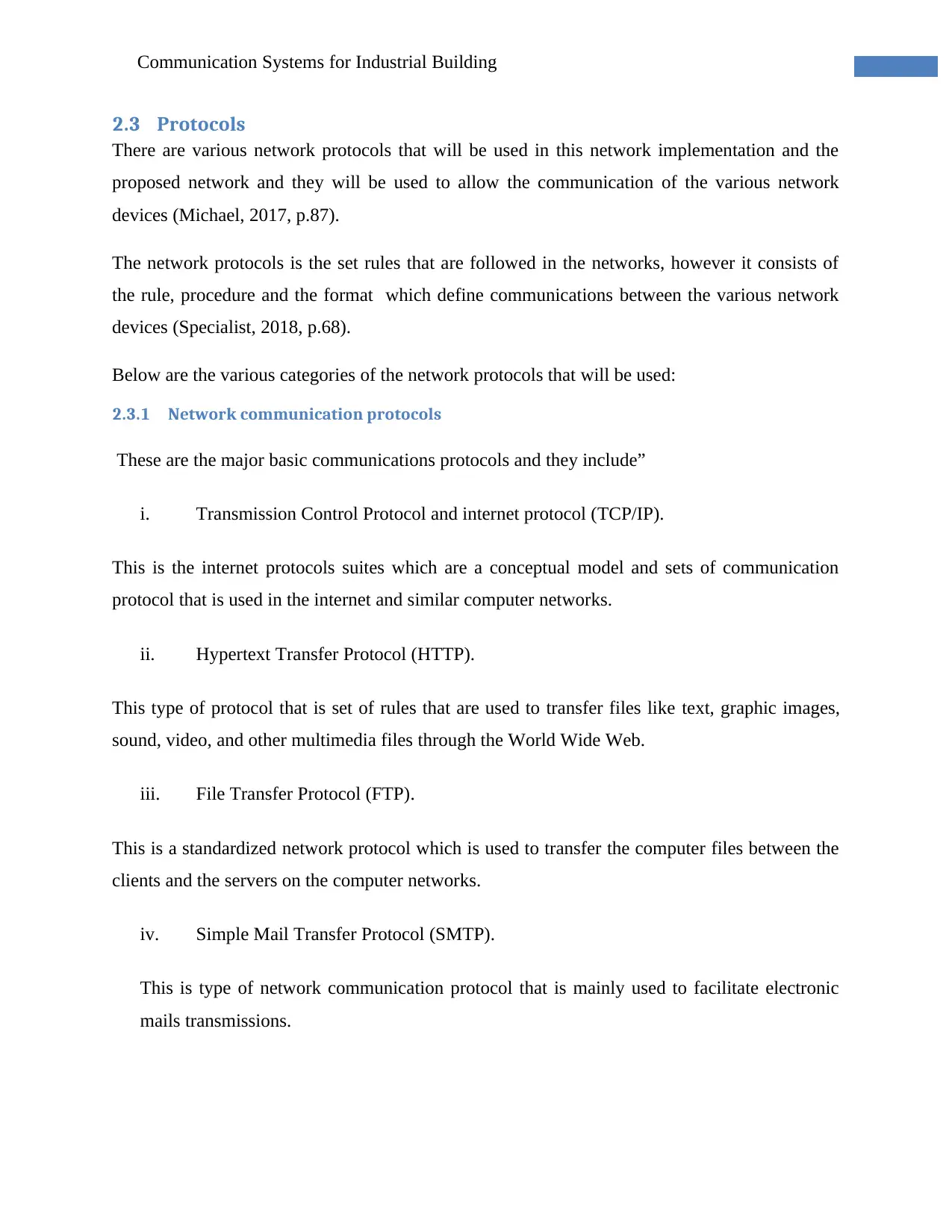
10Communication Systems for Industrial Building
2.3 Protocols
There are various network protocols that will be used in this network implementation and the
proposed network and they will be used to allow the communication of the various network
devices (Michael, 2017, p.87).
The network protocols is the set rules that are followed in the networks, however it consists of
the rule, procedure and the format which define communications between the various network
devices (Specialist, 2018, p.68).
Below are the various categories of the network protocols that will be used:
2.3.1 Network communication protocols
These are the major basic communications protocols and they include”
i. Transmission Control Protocol and internet protocol (TCP/IP).
This is the internet protocols suites which are a conceptual model and sets of communication
protocol that is used in the internet and similar computer networks.
ii. Hypertext Transfer Protocol (HTTP).
This type of protocol that is set of rules that are used to transfer files like text, graphic images,
sound, video, and other multimedia files through the World Wide Web.
iii. File Transfer Protocol (FTP).
This is a standardized network protocol which is used to transfer the computer files between the
clients and the servers on the computer networks.
iv. Simple Mail Transfer Protocol (SMTP).
This is type of network communication protocol that is mainly used to facilitate electronic
mails transmissions.
2.3 Protocols
There are various network protocols that will be used in this network implementation and the
proposed network and they will be used to allow the communication of the various network
devices (Michael, 2017, p.87).
The network protocols is the set rules that are followed in the networks, however it consists of
the rule, procedure and the format which define communications between the various network
devices (Specialist, 2018, p.68).
Below are the various categories of the network protocols that will be used:
2.3.1 Network communication protocols
These are the major basic communications protocols and they include”
i. Transmission Control Protocol and internet protocol (TCP/IP).
This is the internet protocols suites which are a conceptual model and sets of communication
protocol that is used in the internet and similar computer networks.
ii. Hypertext Transfer Protocol (HTTP).
This type of protocol that is set of rules that are used to transfer files like text, graphic images,
sound, video, and other multimedia files through the World Wide Web.
iii. File Transfer Protocol (FTP).
This is a standardized network protocol which is used to transfer the computer files between the
clients and the servers on the computer networks.
iv. Simple Mail Transfer Protocol (SMTP).
This is type of network communication protocol that is mainly used to facilitate electronic
mails transmissions.
Paraphrase This Document
Need a fresh take? Get an instant paraphrase of this document with our AI Paraphraser
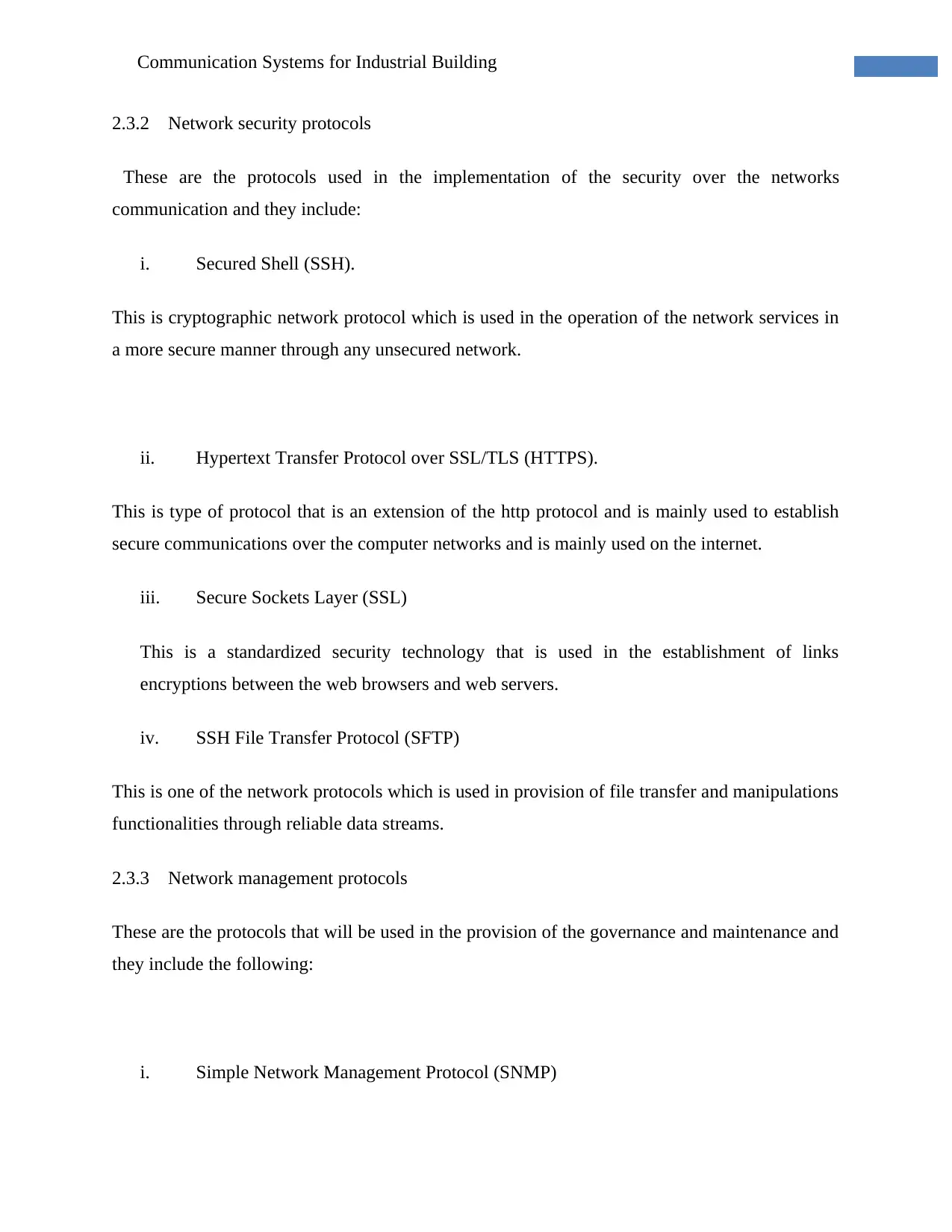
11Communication Systems for Industrial Building
2.3.2 Network security protocols
These are the protocols used in the implementation of the security over the networks
communication and they include:
i. Secured Shell (SSH).
This is cryptographic network protocol which is used in the operation of the network services in
a more secure manner through any unsecured network.
ii. Hypertext Transfer Protocol over SSL/TLS (HTTPS).
This is type of protocol that is an extension of the http protocol and is mainly used to establish
secure communications over the computer networks and is mainly used on the internet.
iii. Secure Sockets Layer (SSL)
This is a standardized security technology that is used in the establishment of links
encryptions between the web browsers and web servers.
iv. SSH File Transfer Protocol (SFTP)
This is one of the network protocols which is used in provision of file transfer and manipulations
functionalities through reliable data streams.
2.3.3 Network management protocols
These are the protocols that will be used in the provision of the governance and maintenance and
they include the following:
i. Simple Network Management Protocol (SNMP)
2.3.2 Network security protocols
These are the protocols used in the implementation of the security over the networks
communication and they include:
i. Secured Shell (SSH).
This is cryptographic network protocol which is used in the operation of the network services in
a more secure manner through any unsecured network.
ii. Hypertext Transfer Protocol over SSL/TLS (HTTPS).
This is type of protocol that is an extension of the http protocol and is mainly used to establish
secure communications over the computer networks and is mainly used on the internet.
iii. Secure Sockets Layer (SSL)
This is a standardized security technology that is used in the establishment of links
encryptions between the web browsers and web servers.
iv. SSH File Transfer Protocol (SFTP)
This is one of the network protocols which is used in provision of file transfer and manipulations
functionalities through reliable data streams.
2.3.3 Network management protocols
These are the protocols that will be used in the provision of the governance and maintenance and
they include the following:
i. Simple Network Management Protocol (SNMP)
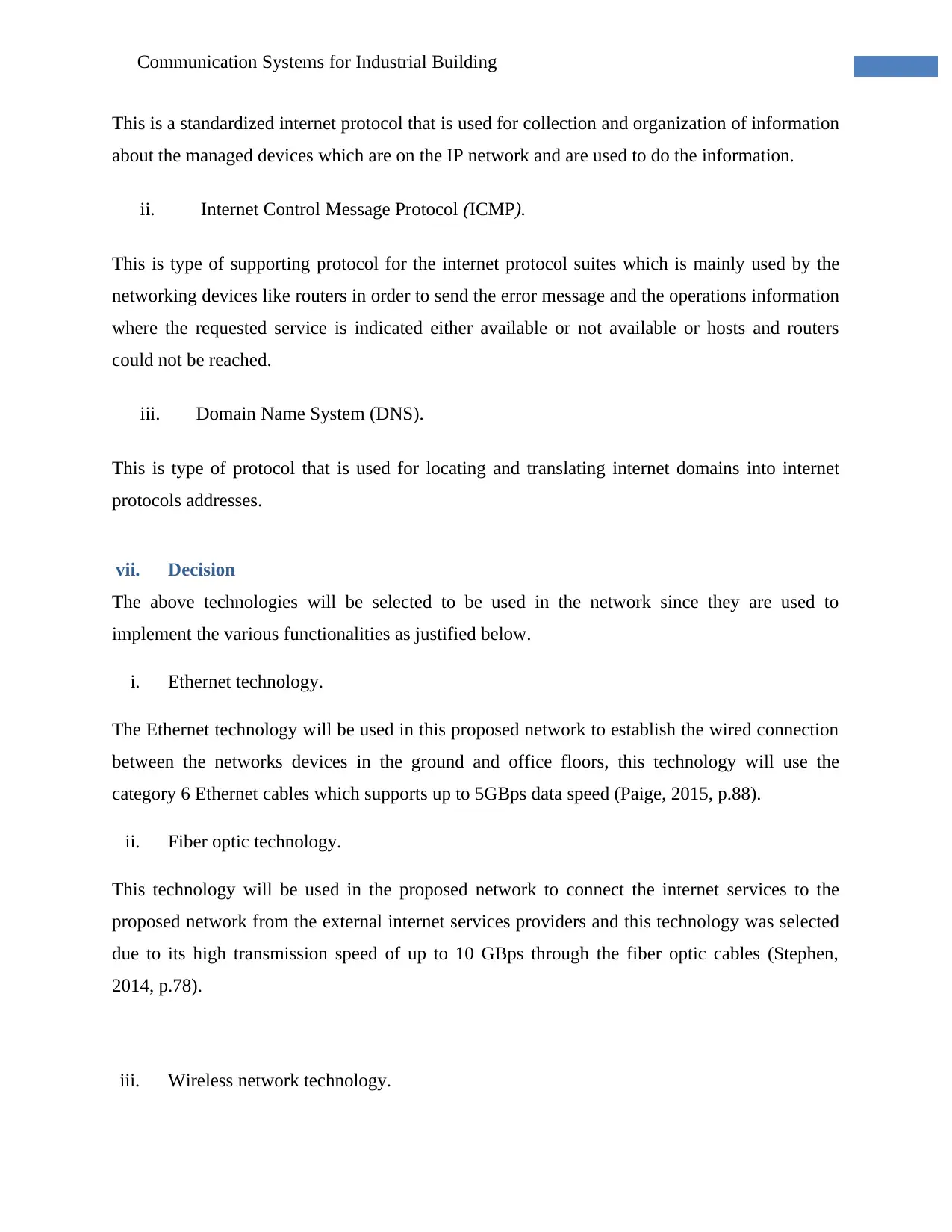
12Communication Systems for Industrial Building
This is a standardized internet protocol that is used for collection and organization of information
about the managed devices which are on the IP network and are used to do the information.
ii. Internet Control Message Protocol (ICMP).
This is type of supporting protocol for the internet protocol suites which is mainly used by the
networking devices like routers in order to send the error message and the operations information
where the requested service is indicated either available or not available or hosts and routers
could not be reached.
iii. Domain Name System (DNS).
This is type of protocol that is used for locating and translating internet domains into internet
protocols addresses.
vii. Decision
The above technologies will be selected to be used in the network since they are used to
implement the various functionalities as justified below.
i. Ethernet technology.
The Ethernet technology will be used in this proposed network to establish the wired connection
between the networks devices in the ground and office floors, this technology will use the
category 6 Ethernet cables which supports up to 5GBps data speed (Paige, 2015, p.88).
ii. Fiber optic technology.
This technology will be used in the proposed network to connect the internet services to the
proposed network from the external internet services providers and this technology was selected
due to its high transmission speed of up to 10 GBps through the fiber optic cables (Stephen,
2014, p.78).
iii. Wireless network technology.
This is a standardized internet protocol that is used for collection and organization of information
about the managed devices which are on the IP network and are used to do the information.
ii. Internet Control Message Protocol (ICMP).
This is type of supporting protocol for the internet protocol suites which is mainly used by the
networking devices like routers in order to send the error message and the operations information
where the requested service is indicated either available or not available or hosts and routers
could not be reached.
iii. Domain Name System (DNS).
This is type of protocol that is used for locating and translating internet domains into internet
protocols addresses.
vii. Decision
The above technologies will be selected to be used in the network since they are used to
implement the various functionalities as justified below.
i. Ethernet technology.
The Ethernet technology will be used in this proposed network to establish the wired connection
between the networks devices in the ground and office floors, this technology will use the
category 6 Ethernet cables which supports up to 5GBps data speed (Paige, 2015, p.88).
ii. Fiber optic technology.
This technology will be used in the proposed network to connect the internet services to the
proposed network from the external internet services providers and this technology was selected
due to its high transmission speed of up to 10 GBps through the fiber optic cables (Stephen,
2014, p.78).
iii. Wireless network technology.
⊘ This is a preview!⊘
Do you want full access?
Subscribe today to unlock all pages.

Trusted by 1+ million students worldwide
1 out of 17
Related Documents
Your All-in-One AI-Powered Toolkit for Academic Success.
+13062052269
info@desklib.com
Available 24*7 on WhatsApp / Email
![[object Object]](/_next/static/media/star-bottom.7253800d.svg)
Unlock your academic potential
Copyright © 2020–2025 A2Z Services. All Rights Reserved. Developed and managed by ZUCOL.





